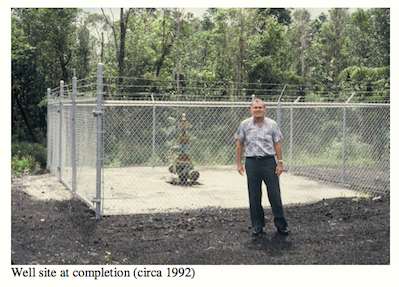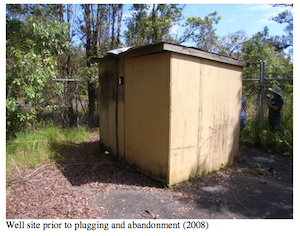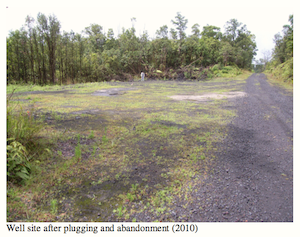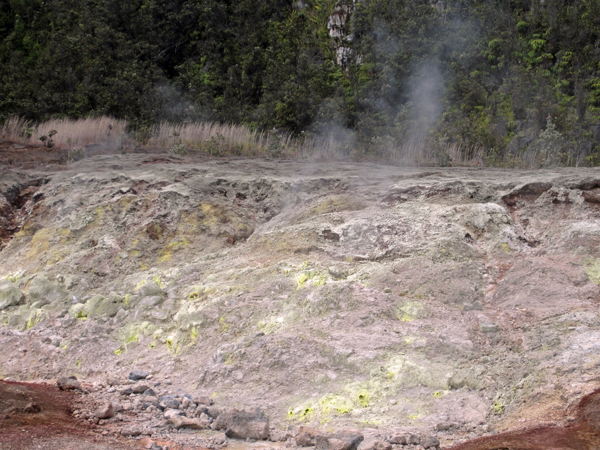Richard Ha writes:
Yesterday there was a County Council meeting, which was called to address the Mayor’s veto of Bills 256 and 257, both related to geothermal.
Eleven folks testified at the Hilo Council chambers and 10 at the Pahoa facility. In Hilo, all were in favor of supporting the Mayor’s veto, and in Pahoa all but three supported it.
We were all puzzled as to why so few members of the opposition showed up. Later we learned that a day before the meeting, the opposition had been notified there would not be a vote. The vote was postponed until August 1st.
The following testimonials are from residents of Leilani Estates, a subdivision that is within a mile of the Puna Geothermal Venture facility. Among much more, they say that some of the folks making claims do not live in the neighborhood, and that they do not know any neighbors who have gotten sick from the geothermal plant.
Here are three testimonials from Leilani Estates residents:
***
I was pleased to hear that the Mayor had vetoed bills 256 and 257 which had somehow made it through the County Council. Now, according to the newspaper at least, the chairman is intending to bring both of these up with the hope of overriding the veto. My opinion, that I have previously stated both in written testimony and in person, is that Bill 256 is incomplete at best and bill 257 is unnecessary.
Bill 256 has been presented to appease a group of activists, many of whom do not even live in the community close to the PGV, which I do live in. It was written using anecdotal comments, hearsay, and with no real science to support it. Bill 257 was written with no regard to the advice from the very agency tasked with creating it. Just why should the County say that one business needs a site specific plan and not another when the responsible department feels that existing evacuation plans are sufficient?
Please, do not:
End Community Benefits funding
Create a poorly defined Buffer Zone
Buy and Condemn perfectly good homes in a thriving subdivision.
De-value my property.
Use County resources unnecessarily.
Legislate in a vacuum, without either medical or scientific data supporting these actions.
Create redundant and unnecessary plans for an unlikely, worst-case scenario.
As I read the existing law there exists a method for increased monitoring and data accumulation. Why don’t you try to find the answers, find the justification for any changes to the law rather than barging ahead based on emotion or, god forbid, politics. I understand that Council members compromise and trade support for each other and that is fine, that’s how it works. But now is the time to get this issue off of the front page and turn your attention to the real issues.
Jay & Sara Bondesen
Leilani Estates
***
My name is Petra Wiesenbauer and I am asking you to not override the mayor’s veto on bill 256, draft 2.
My family and I have lived in Leilani Estates for the past 14 years and are active participants in the Leilani and Pahoa Community. We are registered voters, vote in each election and are very interested in the development, improvements and growth of this local community and economy. We have two children, 7 and 9, who both go to Christian Liberty Academy in Keaau. We own and operate a successful Bed & Breakfast, located on the corner of Makamae and Kahukai Street.
Our B&B is licensed and legally permitted with a Special Use Permit from the County of Hawaii and we have worked hard to build it up to a viable business with a revenue that we pay GE and TA taxes on. Petra runs the B&B and John works full-time for Willocks Construction Corporation. Before coming to the Leilani Estates, we have lived in many places in Europe, the continental US and 2 years on Oahu. But where we are now, is our home and we are vested in this community. Our business is our main source of income and is part of our retirement plan.
The reason we are asking you to vote against bill 256, draft 2 and not override the Mayoral veto is the creation of the one-mile safety buffer zone, in which the County would offer to buy up properties that then would be left uninhabited. We are extremely concerned about this aspect, as we feel, that a decision like this needs to be based on clear scientific evidence of an apparent health threat for the area.
Since there have been no systematic health studies conducted in the past for this area, setting the safety buffer zone at one mile or any distance is completely arbitrary. In our opinion, legislation has to be based on clear facts and not anecdotal evidence. Many of the people testifying in this process against geothermal energy do not live anywhere near the power plant. How can they prove that there health conditions are brought on by the PGV? We live in the one-mile zone and have no health issues at all that we would be able to trace back to the plant. We have friends that have worked at the plant for many years and there is nothing wrong with their health.
We understand what happened during the blow-out of the well in 1991 and are horrified by the affects to the population around the plant back then. However, 21 years later things have changed: Technology is far advanced and safety measures are very strict. In the 14 years we have lived less than 1 mile away from the plant, we have not had any health consequences, dizziness, respiratory problems or weakness that could be contributed to exposure to toxic gases. We know, what pollution, including sulfur looks and smells like, having lived in places, where this is a daily occurrence.
In fact going over to the Kona side is an example of being exposed to bad air through the vog. Never have we felt around our home and community what we feel in Kona: dizziness, headaches and numbness. Before a decision can be made to condemn this area around the plant we ask you to make sure, that there will be evidence gathered systematically and not anecdotally, independent health studies conducted and further research done. We gladly volunteer to participate.
Condemning this area and establishing the one-mile buffer zone at this point would mean that property values are negatively impacted and insurance (homeowners and liability) will either get more expensive or will no longer be available. Without liability insurance we would have to shut down our business. If this bill passes we may lose all of our investment into our home and business, and we would never be able to sell our business someday in the future. We have invested our lifesavings into our business and home and have worked extremely hard. This bill would kill our small business. This area here will be made a ghost area with vacant homes, squatters and drug houses moving in. The economy around Pahoa will take another detrimental hit.
The State Legislature recently passed several bills with changes to the Hawaii State Planning Act to include the development of geothermal energy resources on State Land and it amended the Hawaii State Planning Act to include promoting the development of geothermal energy resources that are located on State Land as a source of firm power to reduce the cost of electricity. Hawaii has the strictest air monitoring standards for geothermal activities in our country, and in fact in the world. Geothermal Energy is an alternative energy, that is available on this island and it would be insane not to use it. It is a matter of making it as safe as possible and passing the benefits of this less expensive energy on to the customers.
Petra Wiesenbauer
***
Aloha Hawaii County Council Members,
My name is Loren Avedon I live in Leilani Estates Puna, and have for the last 3 years. I am writing this testimony is in support of the mayors veto of Bill 256, Draft 2, the legislation to amend Chapter 2 article 36 of the Hawaii County code, the Geothermal Relocation and Community Benefits Fund.
Bill 256 does not represent the “best use” of these funds for many reasons as stated in the Mayor’s veto.
The truth is that a number of homes have been built within a one mile radius after the plant was operational, with full knowledge of the geothermal plant, and its relocation fund.
There is no evidence of any health related issues from the geothermal plant, nor is there evidence that a 1 mile “buffer zone” is necessary. I live approximately on the border of the proposed “buffer zone” and I wish to report that since living in Leilani estates my health has actually improved, and I know not one of my neighbors who are affected by the Geothermal Plant.
Where is the scientific evidence of the need for this 1 mile buffer zone? The answer is there is none. If there is then GPV is clearly endangering the public welfare. So then what is the basis for this Bill? Is it to cover up the truth?
Offering 130% of assessed value for the properties would be a fiasco for the county financially, the fund would quickly be depleted just buying homes and property. Where will the additional money come from? What agency will manage those properties? What use will the county make of that land deemed uninhabitable? How will that affect future property values in the area as well as the county’s ability to allow more test drilling for future geothermal power plant locations? There are plans to drill in West Hawaii, what will happen to those properties and their usability?
This bill is a terrible idea, for the reasons stated in Mayor Kenoi’s Veto. This bill will create more debt and deplete the county’s tax revenue base by making it law!? It just doesn’t make any sense?
I know for a fact that you will ruin my property value, as well as your ability to tax more than 1000 lots in the Leilani subdivision. I expect that if this bill passes it will go to the Hawaii Supreme court for many reasons. In addition I am sure that the remainder of our subdivision will file suit for loss of use, and the county’s negligence in allowing a hazardous activity to be conducted so close to any human population. What evidence of this hazardous activity will for the basis of this suit? It will be the bill signed into law by the county council of Hawaii without any evidence and consideration of future impact.
The county council is setting itself for allot of problems with this legislation, and showing poor judgment and instilling “no confidence” in its leadership decision to support this bill. If the council makes this law, not only will you ruin me, but you will ruin the trust I have in your leadership and most likely raise red flags for any future industries that wish to do business in Hawaii. That may cause the county’s bond rating to drop, cause more deficit spending, and further cripple our financial future for all of Hawaii county.
I feel that to expand the relocation program to anyone who moved there knowingly, is a huge mistake and a waste of the County’s funds and bad for the future of Hawaii county.
Please uphold the Mayor’s veto against Bill 256, Draft 2, the legislation to amend the Geothermal Relocation and Community Benefits Fund.
Thank you again for the opportunity to submit written testimony and for your careful consideration of this matter.
Loren Avedon
Leilani Estates, Hawaii




